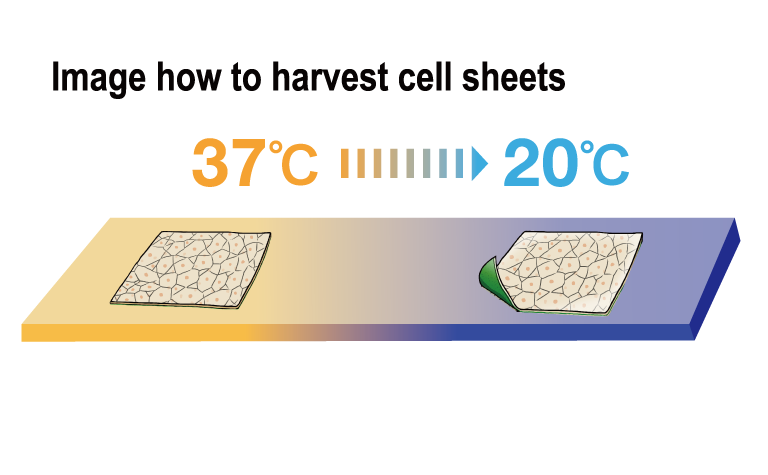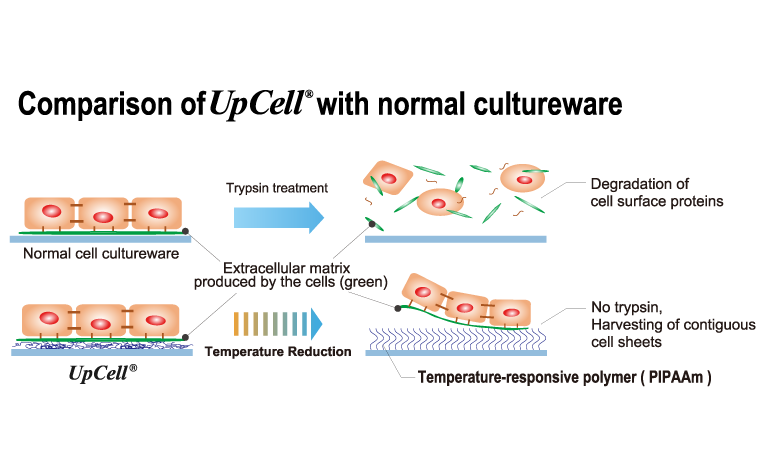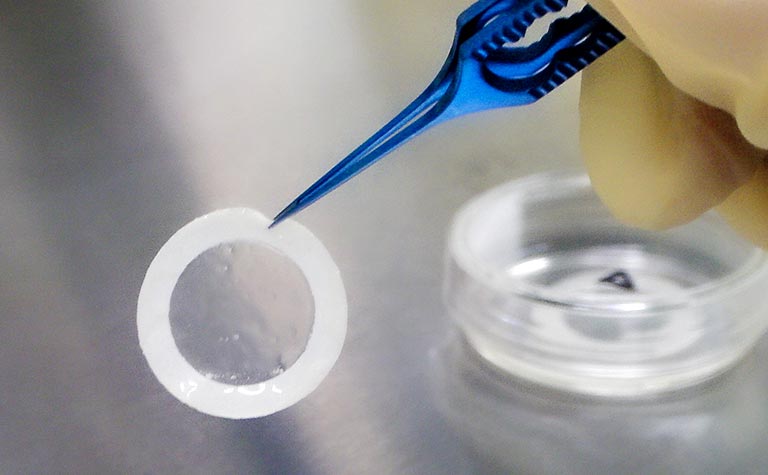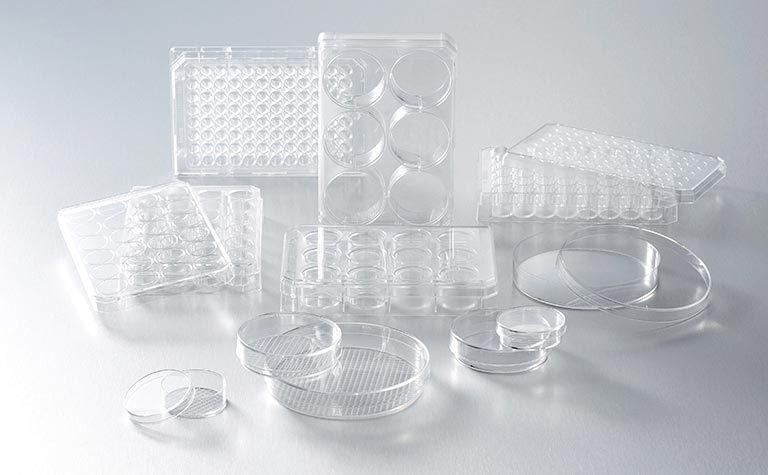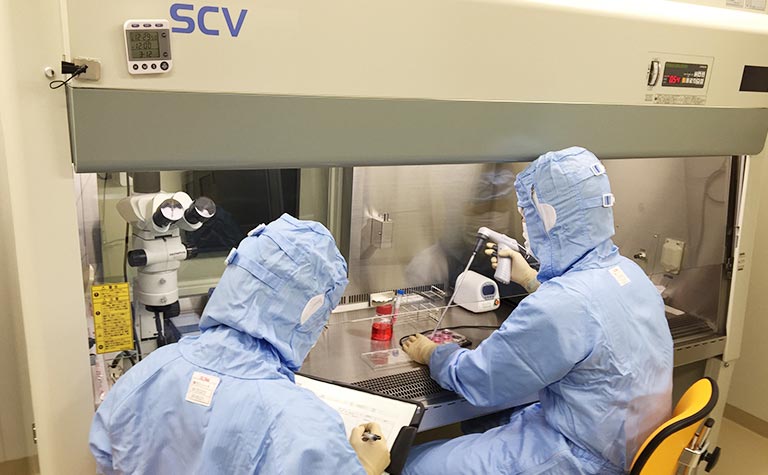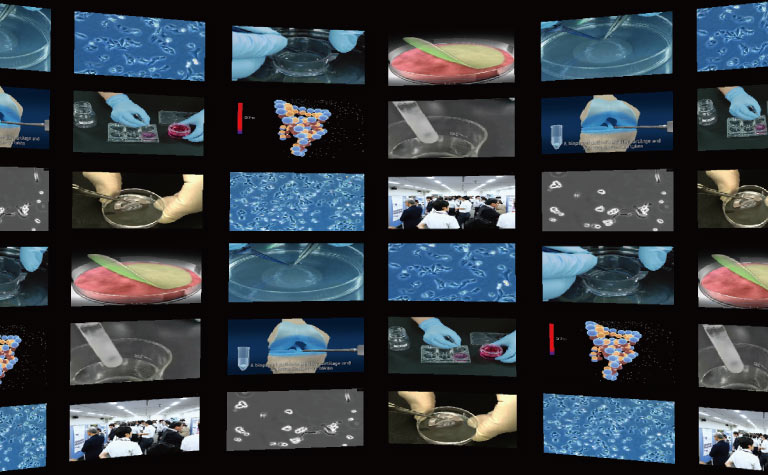UpCell®
Temperature-responsive cell cultureware for "Cell Sheet" engineering

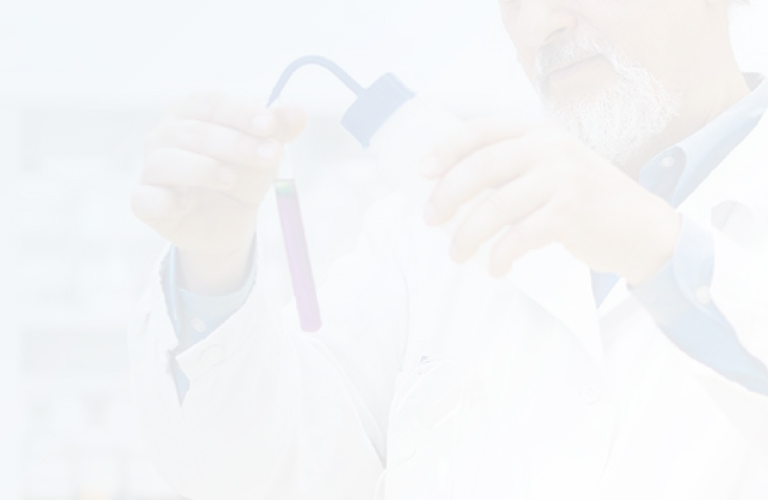
Temperature-responsive polymer (PIPAAm) is immobilized to the surface of the cell cultureware at nano-thickness.
The polymer grafted surface shows reversible hydrophobic - hydrophilic property across the threshold temperature of 32℃, allowing cells to datech in a form of thin film (cell-sheet) WITHOUT harmful enzymes (e.g. trypsin or dispase).
The polymer is covalently bonded to the surface therefore harvested cell-sheet is free from polymer contamination.
- Key features
- Application
- Instruction
- Application data / References
- Specification
- Inquiries and Sample / Catalog requests
Coming soon
-
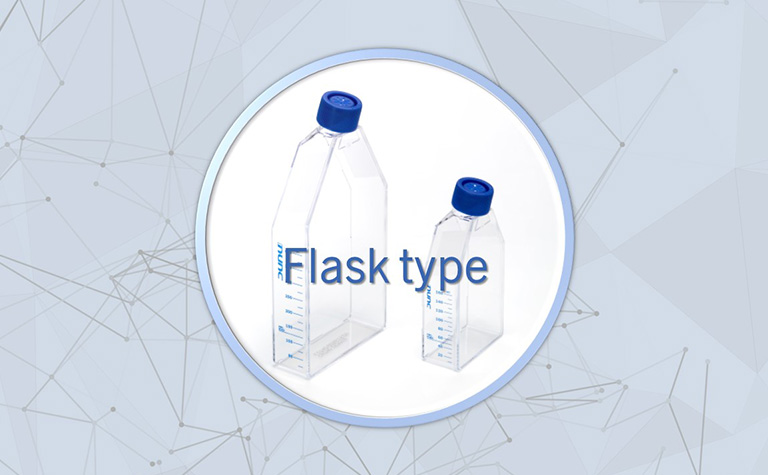
-
New UpCell® products, flask and insert types, will be available soon.
- Flask type
It is possible to collect a large amount of cells that are difficult to exfoliate, such as dendritic cells and macrophages, without damage. - Insert type
Achieves the recovery of cell sheets that maintain a higher level of biological function.
We are accepting sample reservations. Please contact us from the inquiry form for details.
- Flask type
Key features
-
- Collect cultured confluent cells as an intact cell-sheet without enzyme treatment.
- Harvested cell-sheet retains intact basal membranes such as extra cellular matrix (fibronectin, laminin, collagen type IV)
- No suture required for transplantation since fibronectin is kept intact on cells.
- Construction of multiple layered cell-sheet is possible since fibronectin is kept intact on cells.
-
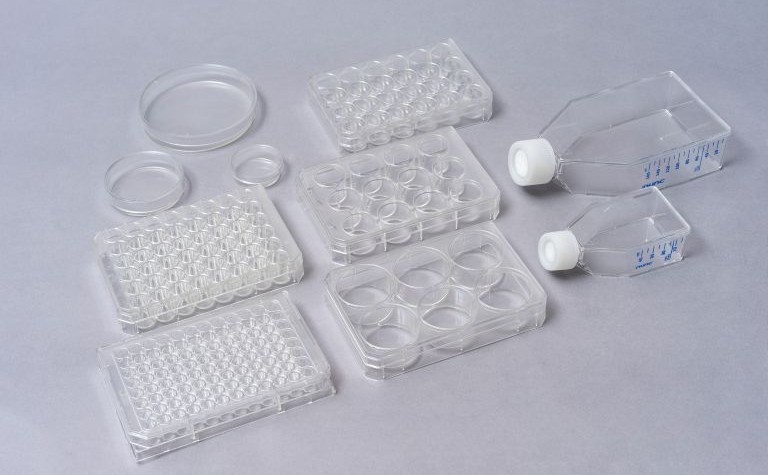
Advantages
- The cells produce their own Extra Cellular Matrix (ECM) to initially bind to the surface of the UpCell® , followed by cell proliferation.
- When cells are cultured beyond over confluence, it can be harvested as a "cell-sheet" by mere regulation of external temperature instead of cell damaging enzymes such as trypsin or dispase. "Cell Sheet" is a contiguous cells in a form of thin film, not isolated cells and free from polymer contamination.
- So-harvested Cell Sheet retains intact extra cellular matrix (ECM) thus suture is not required when transplanting to the host. The ECM acts as a biological binding glue thus accelerate the cell-sheet adhesion without the need for the suture.
- Since the cell surface recepters and antigens are also kept intact due to cell friendly temperature harvest, simple layering of cell-sheets leads to construction of 3D tissue. Cell Sheets communicate and connect to each other through the channels expressed on the surface. The vertical gap junction is formed as short as 30 minutes (results may vary by cell types and specific culture conditions).
Application
- Applicable cell types
-
-
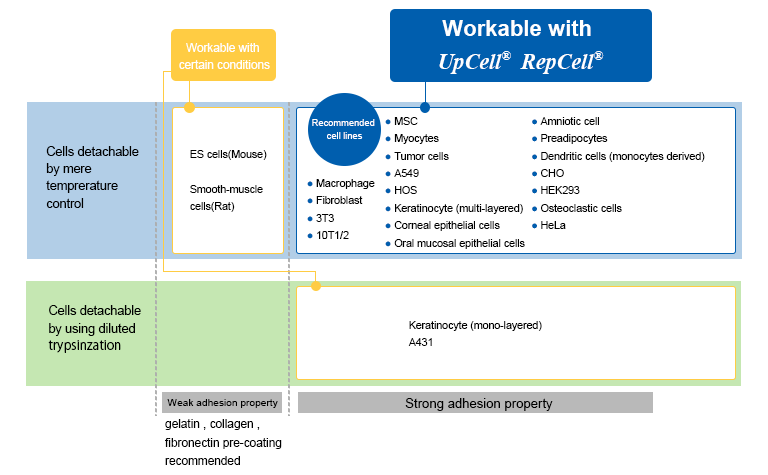
-
- For tissue culture for regenerative medicine
- For construction of 3D tissue. The multi layering of cell-sheets can be either homogeneous or heterogeneous.
-
Instruction
- In vitro cell culture
-
- Please pre-warm the cell culture medium to be used to 37℃ in the incubator.
- When seeding cells, please use the pre-warmed media to ease attachment of cells.
- UpCell® 's temperature-responsive polymer coating is covalently immobilized on the flat surfaces of each cell culture area. The surface becomes slightly hydrophobic above 32℃, allowing adhesion of seeded cells. Therefore please culture cells above this temperature. (Our recommended cell culturing temperature is 37℃.)
Media change can be performed as with non-polymer coated conventional cell cultureware. - Attachment time for cells may vary depending on cells.
- To inhibit undesired cell detachment during media changes, please pre-warm culture media to 37℃ prior to changing the media. Observations under a microscope should also be kept as short as possible to prevent cooling.
- Should you have difficulty in cell attachment, surface pre-coating of the surface with collagen, fibronectin, polylysine or use of serum media may improve cell attachment.
- Detachment of cultured cells
-
- UpCell® TM's surfaces becomes super hydrophilic below 32℃, prompting cell-surface detachment.
- When harvesting cultured cells, place "UpCell® TM" into an incubator set at 20℃ for 30 minutes.
- Alternatively, "UpCell® TM" may be set at room temperature (25℃) under sterile conditions to cool.
- Depending on the cell type, cultured cells should detach spontaneously within a short time.
- Cells failing to detach automatically can be detached by gentle plate agitation using a pipet filled with culture media.
- For the preparation of intact single cell suspension by UpCell®, it is highly recommended to recover cells before cells reach over confluent and form tight cell-cell junction.
- For the preparation of intact single cell suspension by UpCell®, it is highly recommended to recover cells before cells reach over confluent and form tight cell-cell junction.
- The "UpCell®" product is intended for single-use only. Please do not re-use the product as the residual matrix and media components may absorb to the surface, comprising performance.
- Store at room temperature. Avoid direct sunlight.
- Sterilization conditions may also comprise cultureware properties.
- Cell Sheet harvest using membrane
-
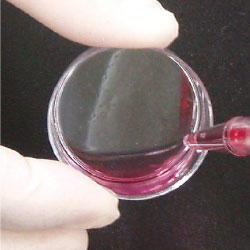
1. Remove most but not all of culture medium to prevent cells from drying from UpCell® cultureware and leave at room temperature (25C) for 10-30 minutes. Please make sure that your cells are cultured beyond over-confluency.
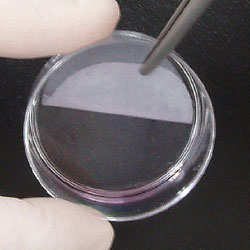
2. Gently place hygroscopic membrane provided in the product box or PVDF membrane on cells as a "cell-sheet carrier".
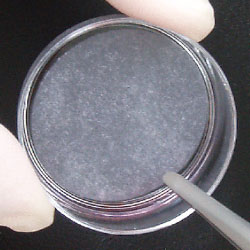
3. Place the edge of cells onto the membrane by using sharp forceps and gently peel the membrane with the cell-sheet off from the surface of UpCell®.
Application data / References
Specification
| Format | Max. external dimensions, mm | Culture area, cm2/well | Suggested working Volume, mL/well | Cat. No. | Units per pack / case |
|---|---|---|---|---|---|
| 96 Multi-well plate | 86(L)×128(W) | 0.33cm2/well | 0.4mL/well | CS1001 | 20 |
| CS1002 | 5 | ||||
| 48 Multi-well plate | 86(L)×128(W) | 1.1cm2/well | 0.5mL/well | CS3001 | 20 |
| CS3011 | 5 | ||||
| 24 Multi-well plate | 86(L)×128(W) | 1.9cm2/well | 1mL/well | CS3002 | 20 |
| CS3012 | 5枚 | ||||
| 12 Multi-well plate | 86(L)×128(W) | 3.5cm2/well | 2mL/well | CS3003 | 20 |
| CS3013 | 5 | ||||
| 6 Multi-well plate | 86(L)×128(W) | 9.6cm2/well | 3mL/well | CS3004 | 20 |
| CS3014 | 5 | ||||
| 10cm dish | 92(D)×17(H) | 56.7cm2 | 12.5mL | CS3005 | 20 |
| CS3015 | 5 | ||||
| 6cm dish | 60(D)×15(H) | 21.5cm2 | 5mL | CS3006 | 20 |
| CS3016 | 5 | ||||
| 3.5cm dish | 40(D)×12(H) | 8.8cm2 | 3mL | CS3007 | 20 |
| CS3017 | 5 | ||||
| High Detachment 3.5cm dish | 40(D)×12(H) | 8.8cm2 | 3mL | CS3101 | 20 |
| CS3111 | 5 | ||||
| Low Detachment 3.5cm dish | 40(D)×12(H) | 8.8cm2 | 3mL | CS3102 | 20 |
| CS3112 | 5 |
Inquiries and Sample / Catalog requests
Click here for frequently asked questions, inquiries and Sample / Catalog requests for UpCell®.

